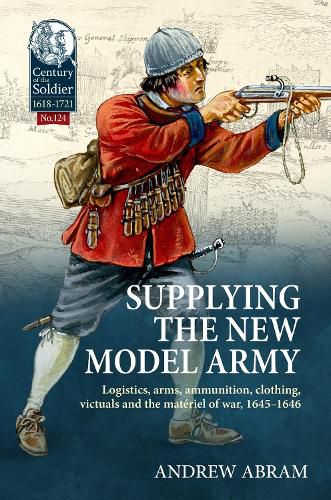Readings Newsletter
Become a Readings Member to make your shopping experience even easier.
Sign in or sign up for free!
You’re not far away from qualifying for FREE standard shipping within Australia
You’ve qualified for FREE standard shipping within Australia
The cart is loading…






The orthodox view of modern writers that armies of the 17th century relied more upon plunder and free quarter is highly pervasive, yet more recent research suggests that during the British Civil Wars there were increasing changes to this custom. The creation, politics, religious identity, officer corps and military campaigns (especially the Battle of Naseby) of the New Model Army, commanded by Sir Thomas Fairfax, have been the focus for various writers, nonetheless, little attention has been paid to the supply and logistics of this force. The result has been a critical gap in the understanding of the recruitment, victualling, ordnance, ammunition, clothing, arming, and logistics employed by the Committee of the Army in both the initial establishment of the New Model and its subsequent campaigns. The methods of sustaining this military force of up to 17,000 men in the field necessarily called for a largely centralised system which operated at an increasingly physical distance from London and the army's headquarters at Reading. Hence, this study challenges the prevailing view that Fairfax's troops increasingly relied upon local sources during 1645 and 1646, rather than an organized system of supply from London manufacturers and other commercial means. Hence, this highly relevant and important topic adds significantly to our knowledge of the supply, strengths and appearance of the New Model, and will appeal to academics, local historians, re-enactors and wargamers. AUTHOR: Having joined the British Army in 1978 aged sixteen, Dr Andrew Abram served as a regular soldier in various theatres, including the South Atlantic. In 1997 he discovered that he could attend university, graduating with a first-class honours degree in history at the University of Wales, Lampeter three years later. In 2007 he was awarded his doctorate by the same institution, being employed there as a teaching fellow and lecturer in medieval history until 2015. Andrew has subsequently acted as an associate lecturer in history at Manchester Metropolitan University, and historical consultant to museums and local groups. He has researched, written about, and taught on medieval and early-modern warfare, and contributed journal articles and book chapters on related topics. More recently, Dr Abram's research interests in the civil war in Cheshire, the northwest of England and the Welsh borders, as well as seventeenth-century conflicts more generally, continues, and he is currently working on a studies of the 1659 Booth Rebellion, and Charles II's army and Tangier for Helion & Company. Andrew lives with his family in the Peak District, where he enjoys travelling, reading crime and naval adventure novels, brewing beer, climbing, hiking, and training for pilgrimages to holy sites. 6 b/w illustrations, 10 b/w photos, 47 tables
$9.00 standard shipping within Australia
FREE standard shipping within Australia for orders over $100.00
Express & International shipping calculated at checkout
The orthodox view of modern writers that armies of the 17th century relied more upon plunder and free quarter is highly pervasive, yet more recent research suggests that during the British Civil Wars there were increasing changes to this custom. The creation, politics, religious identity, officer corps and military campaigns (especially the Battle of Naseby) of the New Model Army, commanded by Sir Thomas Fairfax, have been the focus for various writers, nonetheless, little attention has been paid to the supply and logistics of this force. The result has been a critical gap in the understanding of the recruitment, victualling, ordnance, ammunition, clothing, arming, and logistics employed by the Committee of the Army in both the initial establishment of the New Model and its subsequent campaigns. The methods of sustaining this military force of up to 17,000 men in the field necessarily called for a largely centralised system which operated at an increasingly physical distance from London and the army's headquarters at Reading. Hence, this study challenges the prevailing view that Fairfax's troops increasingly relied upon local sources during 1645 and 1646, rather than an organized system of supply from London manufacturers and other commercial means. Hence, this highly relevant and important topic adds significantly to our knowledge of the supply, strengths and appearance of the New Model, and will appeal to academics, local historians, re-enactors and wargamers. AUTHOR: Having joined the British Army in 1978 aged sixteen, Dr Andrew Abram served as a regular soldier in various theatres, including the South Atlantic. In 1997 he discovered that he could attend university, graduating with a first-class honours degree in history at the University of Wales, Lampeter three years later. In 2007 he was awarded his doctorate by the same institution, being employed there as a teaching fellow and lecturer in medieval history until 2015. Andrew has subsequently acted as an associate lecturer in history at Manchester Metropolitan University, and historical consultant to museums and local groups. He has researched, written about, and taught on medieval and early-modern warfare, and contributed journal articles and book chapters on related topics. More recently, Dr Abram's research interests in the civil war in Cheshire, the northwest of England and the Welsh borders, as well as seventeenth-century conflicts more generally, continues, and he is currently working on a studies of the 1659 Booth Rebellion, and Charles II's army and Tangier for Helion & Company. Andrew lives with his family in the Peak District, where he enjoys travelling, reading crime and naval adventure novels, brewing beer, climbing, hiking, and training for pilgrimages to holy sites. 6 b/w illustrations, 10 b/w photos, 47 tables